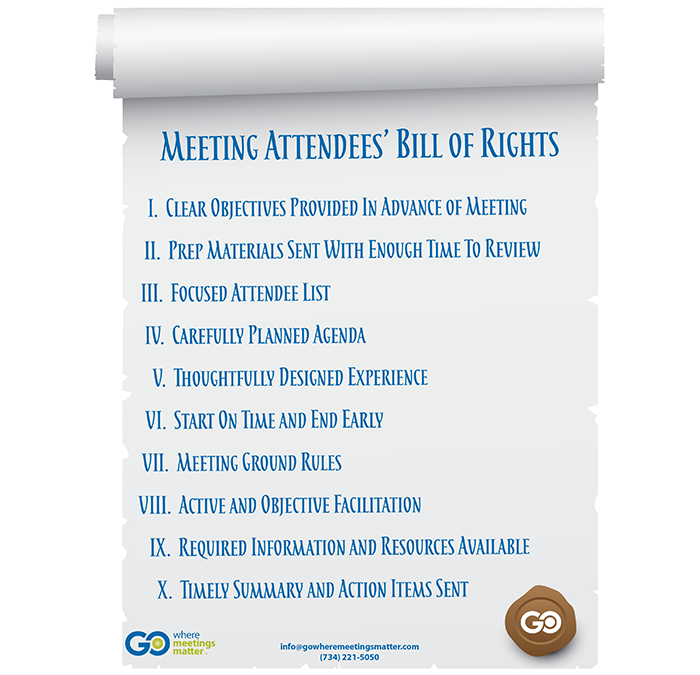We all know that bad meetings waste time and resources and drain your team’s energy and passion. What’s worse is that bad meetings can often result in bad decisions that waste time, money, and other resources on a grander scale. What if your attendees had a Bill of Rights?
I’ve introduced you to the nine keys for successful meetings and discussed how using them can make your meetings more productive and even enjoyable, but how do your attendees know that you’re thinking through the design of the meeting to not waste their time? One way is to adopt a Meeting Attendees Bill of Rights and share it with your organization.
The goal of the Meeting Attendees Bill of Rights is to empower everyone in your organization to be a catalyst for productive meetings and making bad meetings unacceptable. Below is my version of the Meeting Attendees Bill of Rights. Feel free to use and adapt to fit the needs of your organization.
Clear Objective Provided in Advance of the Meeting. The leader / facilitator of the meeting will clearly communicate the desired outcomes and objectives of the meeting with enough time for the invitees to review and prepare their own thoughts and questions.
Preparation Materials Sent with Enough Time to Review. The leader / facilitator recognizes that well prepared attendees will reduce the time needed for the meeting. Sending agendas, objectives, and update information in advance helps prepare attendees to engage and have thoughtful discussion during the meeting.
Focused Attendee List. The leader / facilitator will limit the attendee list to those groups and individuals who have critical input to a discussion and / or are affected by the outcomes of the meeting.
Carefully Planned Agenda. The leader / facilitator will carefully construct an agenda that outlines a reasonable sequence and flow of topics. The leader / facilitator will allow adequate and appropriate (not too much nor too little) time for discussion and breaks.
Thoughtfully Designed Experience. The leader / facilitator recognizes the “How” is as important as the “What” regarding the meeting. The leader / facilitator will thoughtfully design the techniques they will use to accomplish the outcomes, recognizing unstructured / open conversation is rarely effective and efficient. Good meeting design recognizes the tendencies and personalities of the participants, leveraging their strengths and compensating for their bad habits. Good design also outlines roles for taking notes, keeping to the schedule, etc. so the leader / facilitator can focus on the content.
Start on Time and End Early. The leader / facilitator will start the meeting on-time with the attendees who are respectful enough to be on-time. The leader / facilitator recognizes that the attendees committed to being present for the meeting during the scheduled time and will not allow the meeting to continue after the scheduled time and if possible will wrap up with a few minutes for the attendees to connect before the meeting ends.
Meeting Ground Rules. The leader / facilitator will work with the group to establish a set of practices to help the meeting be as effective and efficient as possible. A draft of the meeting guidelines can be sent out with the preparation materials and then agreed to as one of the first items on the agenda. Some ground rules to consider are an expectation that everyone is paying attention (in the room and on the phone), cell phone ringers turned off, etc.
Active and Objective Facilitation. One of the roles assigned during a meeting is that of facilitator. The leader can take this role, but may choose to assign to someone else. The facilitator will ensure that the group moves forward together, not allowing the group to be dominated by individuals with their own agendas or styles. The facilitator is responsible to make sure all voices are heard and that the discussion stays focused on the objectives and agenda.
Required Information and Resources Available. The leader / facilitator will have all required information and resources available at the meeting. If specific data is essential to decision making it is the responsibility of the leader / facilitator to have that data available during the meeting. The leader will also have all resources required for the meeting experience to flow effortlessly. This could include projector and screen, flip charts, markers, and other supplies as well as beverages and snacks.
Timely Summary and Action Items Sent. Once the meeting is complete, the leader / facilitator will send a summary of the key content discussed, the decisions made, and any action items with responsible parties assigned to all meeting attendees. This summary should be sent within a business day of the meeting.
Is there anything in the above list that you disagree with? Did I miss anything you think is important? I would love to hear your thoughts about the Bill of Rights and if you’ve used it in your organization.


Recent Comments